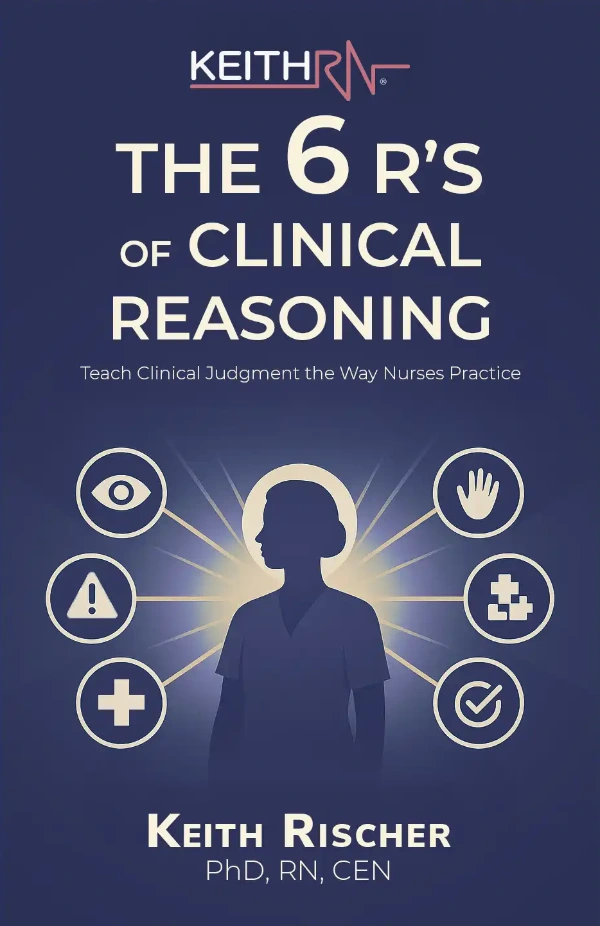
What is the best way to develop the clinical judgment that students require for safe clinical practice?
I have spent the last few months searching for an answer by reading countless journal articles to complete the literature review of my dissertation.
I will be sharing key takeaways from my literature review and need to read articles that are relevant for every nurse educators in the weeks and months ahead in future blogs so stay tuned!
High-fidelity simulation has been all the rage in the nursing literature over the last 10 years and justifiably so as it has been shown to help develop the clinical judgment students require for practice. But the gap I identified in the literature is the lack of research on low-fidelity simulation that includes case studies and other active learning strategies to develop clinical judgment in the classroom. I look forward to implementing my study to determine the effect of case studies on critical thinking, clinical reasoning, and clinical judgment.
One article I recently read, “Using SBAR to Promote Clinical Judgment in Undergraduate Nursing Students” stood out because it used an innovative strategy to develop the clinical judgment that nurse educators can easily utilize in the classroom or even in clinical post-conference to develop nurse thinking that every student requires for safe practice.
Rethinking SBAR
The SBAR (Situation, Background, Assessment, Recommendation) is traditionally used as an acronym to provide a guideline for safe interdisciplinary communication between nurses and other care providers if a problem is identified and needs to be concisely communicated.
But instead of using it in this context, Lancaster, Westphal, and Jambunathan (2015) utilized this tool to determine how 80 second semester junior nursing students enrolled in a pharmacology course could interpret clinical cues in a case study/simulation presented in class that represented a problem that needed to be recognized by the nurse.
How do students notice and interpret relevant clinical cues and then reflect upon this clinical data using the SBAR with an in-class simulation that presented the problem of narcotic oversedation in a postoperative patient was the research question that guided this study.
The focus for this exercise was to see if students could recognize multiple clinical cues of an impending narcotic overdose in a postoperative patient receiving morphine through a PCA.
How it was done
The authors began this activity through an audio nurse to nurse report that included the following RED FLAG clinical data that students needed to notice and interpret:
- the patient was given “a bunch” of morphine and lorazepam in the PACU
- the dose of morphine was at the high limit for an opioid naïve patient
- the patient had not been directly assessed for 90 minutes
- upon entering the room the patient was lethargic but could be aroused
Additional written cues were provided to students which included the PCA assessment flowchart and the policy and procedures for proper PCA use and management of a narcotic overdose.
Each student had an SBAR shift report tool that they were required to fill out as this case study/simulation unfolded beginning with the nurse report.
Students needed to identify not only what clinical data was most important or noticed but using the “R” of recommendation were required to interpret the data correctly to identify the priority action and recommendation to the primary care provider.
Findings
Only 22% of students were able to demonstrate safe clinical decision-making by both noticing concerning clinical cues and identifying the need to respond to assess the patient ASAP to collect further data and evaluate the current status of the patient.
Ironically, this is about the same percentage of graduate nurses (23%) that Kavanagh and Szweda (2017) identified met entry-level expectations of clinical judgment in their study titled “A Crisis in Competency…”
These findings suggest the majority of students were unable to make a correct clinical judgment by using all four steps of Tanner’s clinical judgment model, which includes effective noticing, interpreting, responding, and reflecting.
All students noticed the decreased level of consciousness cue, but most were unable to interpret additional relevant cues and respond to the problem correctly.
Recommendations
The authors concluded that using SBAR as a summative or evaluative assessment tool with case-based learning could strengthen clinical judgment.
Using SBAR appears to be an effective strategy to better prepare students for complex clinical practice situations by providing students with opportunities to recognize clinical cues of patient deterioration and communicate this concisely to a clinician.
Takeaways for Educators
Why do most students struggle to make the connection between abnormal clinical cues but not able to connect the pieces or interpret data correctly? This is the essence of critical thinking that many students lack because they do not deeply understand essential content, especially pathophysiology.
When pathophysiology is deeply understood the WHY of clinical data that is abnormal becomes readily apparent.
To teach the importance of pathophysiology to students it must also be deeply understood and its importance recognized by nurse educators.
If pathophysiology does not come easy to you (it doesn’t for most!) make it a priority as an educator to make this weakness a strength the next time you enter the classroom. This is needed to strengthen and transform the way you teach and improve practice readiness of your students.
Create an SBAR Culture!
The authors of this study also encouraged nurse educators to create a culture of SBAR to practice identifying clinical signs of patient deterioration and communicating these findings in a timely standardized fashion.
By utilizing this acronym and tool to develop nurse thinking and clinical decision-making consider the following activities to create an SBAR culture in your program!
- Use SBAR format as the framework for all student and faculty email communication to promote familiarity and consistency with this framework.
- I love this recommendation by the authors of this study!
- Use SBAR as a framework for summative or evaluation with simulation or a case study
- Practice SBAR consistently in your classroom with a case study when communication with a care provider or another nurse is needed
Adapt to Your Classroom
Though the authors of this study used an in-class simulation, you can make learning active and develop the clinical decision-making your students require for practice by integrating a case study in your classroom with an opening scenario that contains numerous clinical cues that are abnormal and recognize a problem.
Have an SBAR form that each student can work through or better yet do in small groups to not only notice what is wrong but make the connection of INTERPRETING the data with the right recommendation that recognizes a problem and the need for a response by the nurse.
This is the reason nurses fail to rescue in practice. By practicing this essential nurse thinking skill, this simple strategy may improve the clinical judgment/practice readiness of your students!
Closing Thoughts
There is no shortcut to developing the clinical judgment that each of your students must acquire before graduation.
Learning must be active in your classroom so you can provide opportunities to practice clinical decision making using case studies of the SBAR activity using a salient clinical scenario in the safety of your classroom.
Be creative, have fun and break the mold of the traditional lecture using the SBAR to help students develop all aspects of nurse thinking that includes noticing what’s relevant, interpreting the meaning of clinical cues, and responding appropriately.
Make it a priority to practice these essential nurse thinking skills so your students graduate prepared for practice and be successful on the current or upcoming Next Generation NCLEX!
What will be your next step to incorporate SBAR into your content to strengthen student learning?
Related Blogs
- Why Pathophysiology Must Be Deeply Understood to Think More Like a Nurse
- What Students Can Learn from Airline Pilots to Think More Like a Nurse
- Two Questions to Ask Students in Clinical to Think More Like a Nurse
References
- Kavanagh, J. & Szweda, J. (2017). A crisis in competency: The strategic and ethical imperative to assessing new graduate nurses’ clinical reasoning. Nursing Education Perspectives 38(2), 57-62.
- Lancaster, R. J., Westphal, J., & Jambunathan, J. (2015). Using SBAR to promote clinical judgment in undergraduate nursing students. Journal of Nursing Education, 54(3), S31–S34. https://doi.org/10.3928/01484834-20150218-08
Keith Rischer – PhD, RN, CEN
As a nurse with over 35 years of experience who remained in practice as an educator, I’ve witnessed the gap between how nursing is taught and how it is practiced, and I decided to do something about it! Read more…
The Ultimate Solution to Develop Clinical Judgment Skills
KeithRN’s Think Like a Nurse Membership
Access exclusive active learning resources for faculty and students, including KeithRN Case Studies, making it your go-to resource.





What a great idea! Its simple and can be used in any clinical situation and with any case study.
Hi Cheree! Thanks for sharing. I too saw the immediate value of this strategy after I read the article. Glad to see that you concur!